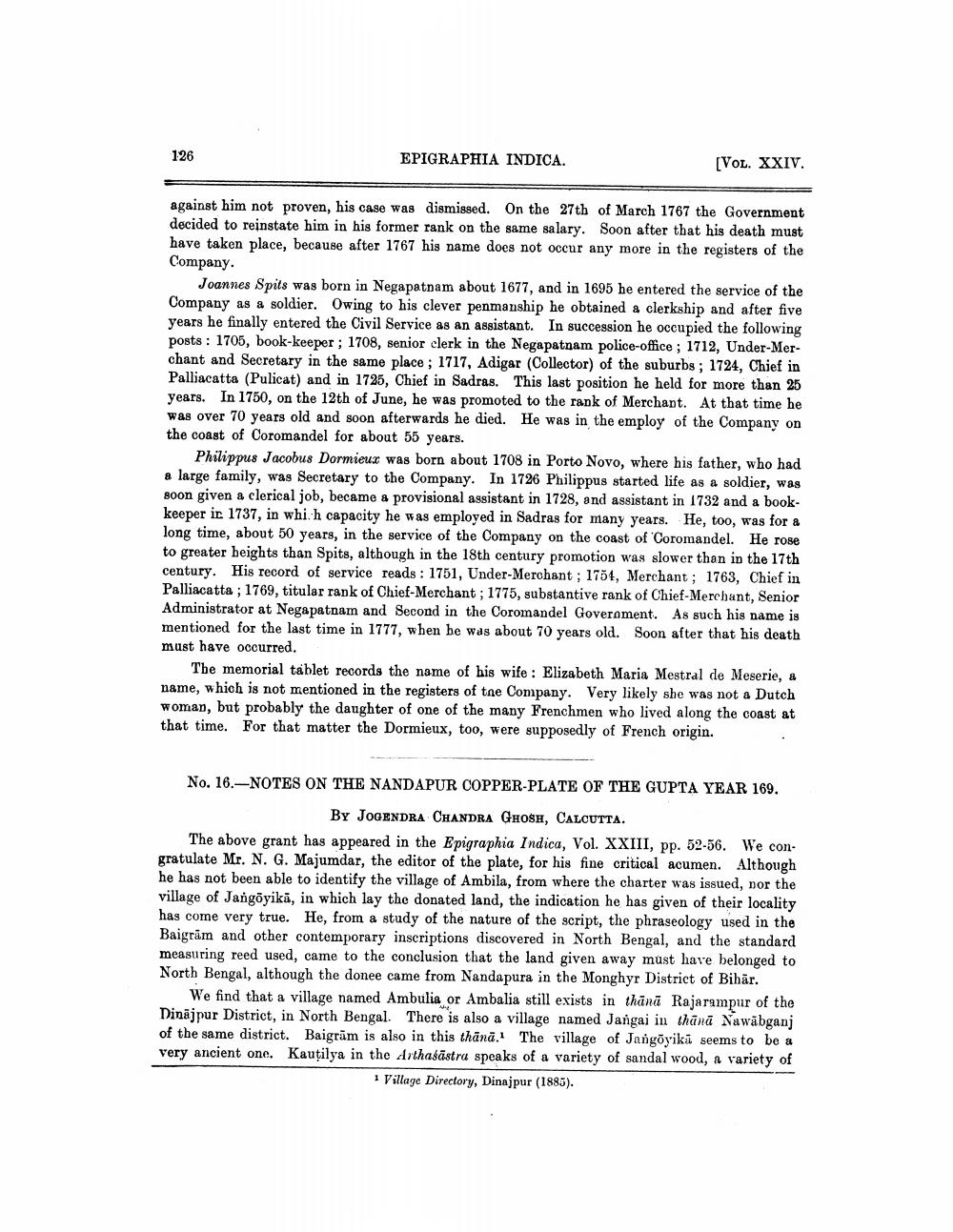________________
126
EPIGRAPHIA INDICA.
[VOL. XXIV.
against him not proven, his case was dismissed. On the 27th of March 1767 the Government decided to reinstate him in his former rank on the same salary. Soon after that his death must have taken place, because after 1767 his name does not occur any more in the registers of the Company.
Joannes Spits was born in Negapatnam about 1677, and in 1695 he entered the service of the Company as a soldier. Owing to his clever penmanship he obtained & clerkship and after five years he finally entered the Civil Service as an assistant. In succession he occupied the following Posts: 1705, book-keeper; 1708, senior clerk in the Negapatnam police office ; 1712, Under-Merchant and Secretary in the same place ; 1717, Adigar (Collector) of the suburbs; 1724, Chief in Palliacatta (Pulicat) and in 1725, Chief in Sadras. This last position he held for more than 25 years. In 1750, on the 12th of June, he was promoted to the rank of Merchant. At that time he was over 70 years old and soon afterwards he died. He was in the employ of the Company on the coast of Coromandel for about 55 years.
Philippus Jacobus Dormieuw was born about 1708 in Porto Novo, where his father, who had a large family, was Secretary to the Company. In 1726 Philippus started life as a soldier, was soon given a clerical job, became a provisional assistant in 1728, and assistant in 1732 and a bookkeeper in 1737, in which capacity he was employed in Sadras for many years. He, too, was for a long time, about 50 years, in the service of the Company on the coast of Coromandel. He rose to greater heights than Spits, although in the 18th century promotion was slower than in the 17th century. His record of service reads : 1751, Under-Merchant ; 1754, Merchant ; 1763, Chief in Palliacatta ; 1769, titular rank of Chief-Merchant; 1775, substantive rank of Chief-Merchant, Senior Administrator at Negapatnam and Second in the Coromandel Goveroment. As such his name is mentioned for the last time in 1777, when he was about 70 years old. Soon after that his death must have occurred.
The memorial tablet records the name of his wife : Elizabeth Maria Mestral de Meserie, a name, which is not mentioned in the registers of the Company. Very likely sho was not a Dutch woman, but probably the daughter of one of the many Frenchmen who lived along the coast at that time. For that matter the Dormieux, too, were supposedly of French origin.
No. 16.-NOTES ON THE NANDAPUR COPPER-PLATE OF THE GUPTA YEAR 169.
BY JOGENDRA CHANDRA GHOSH, CALCUTTA. The above grant has appeared in the Epigraphia Indica, Vol. XXIII, pp. 52-56. We congratulate Mr. N. G. Majumdar, the editor of the plate, for his fine critical acumen. Although he has not been able to identify the village of Ambila, from where the charter was issued, nor the village of Jangöyikā, in which lay the donated land, the indication he has given of their locality has come very true. He, from a study of the nature of the script, the phraseology used in the Baigram and other contemporary inscriptions discovered in North Bengal, and the standard measuring reed used, came to the conclusion that the land given away must have belonged to North Bengal, although the donee came from Nandapura in the Monghyr District of Bihär.
We find that a village named Ambulia or Ambalia still exists in thānā Rajarampur of the Dinajpur District, in North Bengal. There is also a village named Jangai in thânā Nawabganj of the same district. Baigram is also in this thānā. The village of Jangöyiki seems to be a very ancient one. Kautilya in the Arthaśāstra speaks of a variety of sandal wood, a variety of
Village Directory, Dinajpur (1885).




